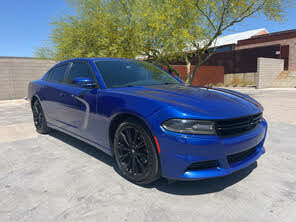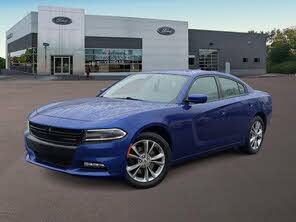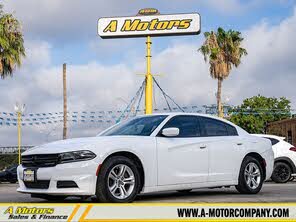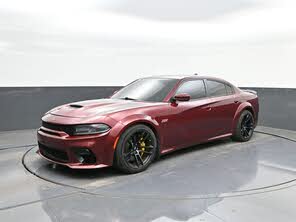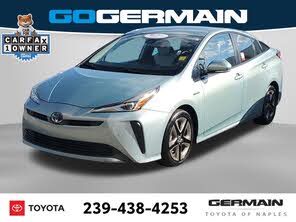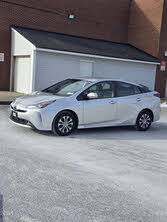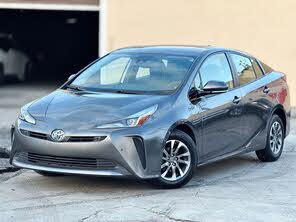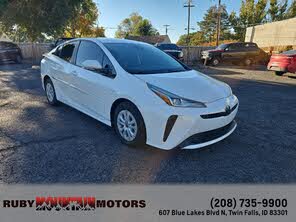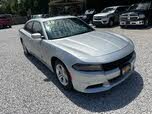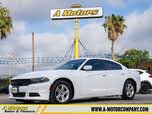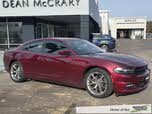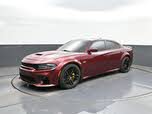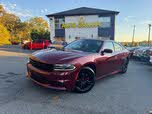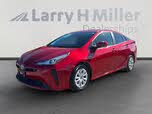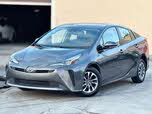2020 Dodge Charger vs 2019 Toyota Prius
Overview | |
MSRP$23,770 | MSRP$29,995 |
Listings207 | Listings759 |
Ratings & Reviews | |
User Reviews | User Reviews |
Expert reviews7.3 out of 10 | Expert reviews8.5 out of 10 |
Pros
Cons
| Pros
Cons
|
2019 Toyota Prius Reviews SummaryReliable, efficient, affordable, practical, and safe, the 2019 Toyota Prius checks off multiple boxes on a typical car shopper’s list. The latest version is even decent to drive, but the Prius' styling does the car no favors. For 2019, Toyota tries to tone down the design, revises its trim-level strategy, and adds a new electric all-wheel-drive option to the car. | |
2020 Dodge Charger Reviews SummaryThe Dodge Charger represents an all-in-one approach to modern performance. Unlike its Challenger coupe counterpart, the Charger is a sedan, providing the usability of four full doors and five-passenger seating. It offers a wide variety of potent powertrains, as well as the availability of all-wheel drive (AWD). The Charger also provides the latest tech and infotainment features. It may be a classic nameplate, but it is a very different approach to the family sedan. This also makes it a breath of fresh air in the modern sedan market. Thanks to its wide variety of performance models, the Charger's exact competition is hard to pin down. V6-powered versions like the SXT and GT compete with the likes of the Toyota Avalon, Nissan Maxima, and Chevrolet Impala. But the available performance on tap with R/T and Hellcat models opens it up to a world of sports cars and muscle cars. Which model you select determines its rivals. No matter the trim selected, the Charger provides a baseline of athleticism paired with a spacious cabin, large rear seats, and a large trunk. Together, these make the Charger a fun and functional new car, with styling that helps it stand out in a crowd. | |
No video found | |
Popular Features & Specs | |
Engine1.8L 121 hp I4 Hybrid | Engine3.6L 292 hp V6 |
Drive TrainFWD | Drive TrainRWD |
Seating Capacity5 | Seating Capacity5 |
Horsepower | Horsepower292 hp @ 6350 rpm |
EV Battery Capacity0.7 kWh | EV Battery Capacity |
MPG City58 | MPG City19 |
MPG Highway53 | MPG Highway30 |
Engine | |
Engine Name1.8L 121 hp I4 Hybrid | Engine Name3.6L 292 hp V6 |
Torque | Torque260 lb-ft @ 4800 rpm |
Horsepower | Horsepower292 hp @ 6350 rpm |
DrivetrainFWD | DrivetrainRWD |
Fuel Economy | |
EV Battery Capacity0.7 kWh | EV Battery Capacity |
MPG City58 | MPG City19 |
MPG Highway53 | MPG Highway30 |
Interior | |
Seating Capacity5 | Seating Capacity5 |
Safety | |
Front Crash Overall4 | Front Crash Overall4 |
Side Crash Overall5 | Side Crash Overall5 |
Dimensions & Capacity | |
Cargo Space27.4 cu ft | Cargo Space16.5 cu ft |
Curb Weight3010 lbs | Curb Weight3964 lbs |
Height57.9 in | Height57.8 in |
Length180.0 in | Length198.4 in |
Width69.3 in | Width82.7 in |
Wheelbase106.3 in | Wheelbase120.0 in |
Maximum Payload825 lbs | Maximum Payload1136 lbs |
Number of doors4 | Number of doors4 |
Maximum Towing Capacity | Maximum Towing Capacity1000 lbs |
Overview | ||
MSRP | $23,770 | $29,995 |
Listings | ||
Ratings & Reviews | ||
User reviews | ||
Expert reviews | 7.3 out of 10Read full review | 8.5 out of 10Read full review |
Pros & cons | Pros
Cons
| Pros
Cons
|
Summary | Reliable, efficient, affordable, practical, and safe, the 2019 Toyota Prius checks off multiple boxes on a typical car shopper’s list. The latest version is even decent to drive, but the Prius' styling does the car no favors. For 2019, Toyota tries to tone down the design, revises its trim-level strategy, and adds a new electric all-wheel-drive option to the car. | The Dodge Charger represents an all-in-one approach to modern performance. Unlike its Challenger coupe counterpart, the Charger is a sedan, providing the usability of four full doors and five-passenger seating. It offers a wide variety of potent powertrains, as well as the availability of all-wheel drive (AWD). The Charger also provides the latest tech and infotainment features. It may be a classic nameplate, but it is a very different approach to the family sedan. This also makes it a breath of fresh air in the modern sedan market. Thanks to its wide variety of performance models, the Charger's exact competition is hard to pin down. V6-powered versions like the SXT and GT compete with the likes of the Toyota Avalon, Nissan Maxima, and Chevrolet Impala. But the available performance on tap with R/T and Hellcat models opens it up to a world of sports cars and muscle cars. Which model you select determines its rivals. No matter the trim selected, the Charger provides a baseline of athleticism paired with a spacious cabin, large rear seats, and a large trunk. Together, these make the Charger a fun and functional new car, with styling that helps it stand out in a crowd. |
Video | No video found | |
Popular Features & Specs | ||
Engine | 1.8L 121 hp I4 Hybrid | 3.6L 292 hp V6 |
Drive Train | FWD | RWD |
Seating Capacity | 5 | 5 |
Horsepower | 292 hp @ 6350 rpm | |
EV Battery Capacity | 0.7 kWh | |
MPG City | 58 | 19 |
MPG Highway | 53 | 30 |
Engine | ||
Engine Name | 1.8L 121 hp I4 Hybrid | 3.6L 292 hp V6 |
Torque | 260 lb-ft @ 4800 rpm | |
Horsepower | 292 hp @ 6350 rpm | |
Drivetrain | FWD | RWD |
Fuel Economy | ||
EV Battery Capacity | 0.7 kWh | |
MPG City | 58 | 19 |
MPG Highway | 53 | 30 |
Interior | ||
Seating Capacity | 5 | 5 |
Safety | ||
Front Crash Overall | 4 | 4 |
Side Crash Overall | 5 | 5 |
Dimensions & Capacity | ||
Cargo Space | 27.4 cu ft | 16.5 cu ft |
Curb Weight | 3010 lbs | 3964 lbs |
Height | 57.9 in | 57.8 in |
Length | 180.0 in | 198.4 in |
Width | 69.3 in | 82.7 in |
Wheelbase | 106.3 in | 120.0 in |
Maximum Payload | 825 lbs | 1136 lbs |
Number of doors | 4 | 4 |
Maximum Towing Capacity | 1000 lbs | |
The 2019 Toyota Prius was not known for its looks. Its design, especially in the fourth generation introduced in 2016, was considered more extroverted but arguably less appealing. Despite its unconventional appearance, the Prius offered a practical solution for daily driving with a range of trim levels and an optional all-wheel-drive system. The interior, while unusual, centralized all controls and featured a mix of modern and dated elements. The gloss black trim, however, was a dust magnet.
In contrast, the 2020 Dodge Charger maintained a modern muscle car aesthetic, with a significant facelift in 2015 that enhanced its aggressive look. The interior blended retro and modern elements, with large vintage-looking bezels housing digital displays. The rear-wheel-drive platform contributed to a cockpit-like feel for the driver and front passenger. The Charger offered various trim levels, each with distinct visual and performance features, making it a versatile choice for those seeking both style and substance.











The 2019 Toyota Prius combined a 1.8-liter 4-cylinder gasoline engine with an electric motor to produce 121 horsepower. The optional AWD-e system added a 5-kilowatt rear electric motor, which powered the rear wheels up to 43 mph. The AWD-e system slightly reduced fuel economy, with the AWD-e model achieving 50 mpg compared to the standard Prius's 52 mpg. The Prius featured a continuously variable transmission (CVT) and offered a smooth, quiet ride, especially in urban settings. The car's aerodynamic design and modest tires contributed to its efficiency and low noise levels.
The 2020 Dodge Charger offered a range of powertrains, starting with a 3.6-liter V6 engine producing 292 horsepower in the SXT trim and 300 horsepower in the GT trim. The R/T trim featured a 5.7-liter Hemi V8 with 370 horsepower, while the R/T Scat Pack boasted a 6.4-liter Hemi V8 with 485 horsepower. The top-of-the-line Charger SRT Hellcat Widebody came with a supercharged 6.2-liter V8, delivering an astounding 707 horsepower. The Charger provided a thrilling driving experience, with various performance features like Brembo brakes, adaptive suspension, and launch assist, making it a formidable contender in the performance sedan segment.
The 2019 Toyota Prius offered comfortable seating for four adults, with manual height adjustment for the driver's seat and heated front seats. Rear passengers enjoyed decent legroom and thigh support, though air conditioning vents were absent in the second row. The Prius's hatchback design provided ample cargo space, with up to 27.4 cubic feet behind the rear seat and 65.5 cubic feet with the seats folded down. The AWD-e model had slightly reduced cargo space but still offered practicality comparable to small crossover SUVs.
The 2020 Dodge Charger excelled in interior space, providing ample legroom for rear passengers, even with the front seats slid back. The front bucket seats were well-bolstered, offering plenty of head- and legroom. The Charger featured practical storage solutions, including door trays, cup holders, and a spacious center console. The trunk offered 16.5 cubic feet of space, which was impressive for a performance sedan and above average for a large family sedan. The 60/40 split-fold rear bench added to the Charger's versatility.
The 2019 Toyota Prius's most advanced infotainment system was limited to the Limited trim, featuring an 11.6-inch touchscreen, navigation, and a premium JBL sound system. The standard infotainment setup included a 6.1-inch touchscreen, Bluetooth, and a CD player. The Prius's instrumentation was housed in a horizontal strip below the windshield, with a mix of modern and dated displays. The Advanced Technology Package added a head-up display and adaptive headlights but fell short of expectations. Notably, the Prius lacked Apple CarPlay and Android Auto integration.
The 2020 Dodge Charger came standard with a 7-inch touchscreen running the Uconnect infotainment system, with higher trims featuring an 8.4-inch screen. Uconnect offered Bluetooth, USB connectivity, satellite radio, HD radio, Apple CarPlay, and Android Auto. The system's intuitive layout and docked icons made it easy to navigate between functions. The Charger's digital display screen in the instrument panel provided essential information and turn-by-turn navigation, enhancing the overall user experience.
The 2019 Toyota Prius offered the Safety Connect service on the Limited trim, providing automatic collision notification, emergency assistance, and roadside assistance. Standard safety features included adaptive cruise control, forward-collision warning with automatic emergency braking, lane-departure warning, lane-keeping assist, and automatic high-beam headlights. The LE trim added blind-spot monitoring, rear cross-traffic alert, and parking assist. The Prius received a 5-star rating from the federal government and a Top Safety Pick rating from the IIHS.
The 2020 Dodge Charger came with standard front- and side-impact airbags, traction control, and rear parking sensors. Optional safety features included forward-collision avoidance, lane-departure warning, lane-keeping assist, adaptive cruise control, and automatic high-beams. Additional options included blind-spot monitoring, rear cross-traffic alert, and rain-sensing windshield wipers. The Charger's crash prevention technology earned a Superior rating from the IIHS, though many of these features were optional rather than standard.
CarGurus highlights

According to CarGurus experts, the overall rating for the 2019 Toyota Prius is 7.3 out of 10, while the 2020 Dodge Charger scores 8.5 out of 10. Based on these ratings, the 2020 Dodge Charger is the recommended choice, offering superior performance, advanced technology, and a spacious interior that caters to both driving enthusiasts and families alike.
Choose the 2020 Dodge Charger if:
- You seek a high-performance sedan with powerful engine options.
- You need a spacious interior with ample legroom for rear passengers.
- You appreciate advanced infotainment technology with Apple CarPlay and Android Auto.
Choose the 2019 Toyota Prius if:
- You prioritize fuel efficiency and low running costs.
- You need a practical, spacious hatchback with ample cargo space.
- You value standard advanced safety features.
CarGurus highlights

According to CarGurus experts, the overall rating for the 2019 Toyota Prius is 7.3 out of 10, while the 2020 Dodge Charger scores 8.5 out of 10. Based on these ratings, the 2020 Dodge Charger is the recommended choice, offering superior performance, advanced technology, and a spacious interior that caters to both driving enthusiasts and families alike.
Choose the 2020 Dodge Charger if:
Shop Now- You seek a high-performance sedan with powerful engine options.
- You need a spacious interior with ample legroom for rear passengers.
- You appreciate advanced infotainment technology with Apple CarPlay and Android Auto.
Choose the 2019 Toyota Prius if:
Shop Now- You prioritize fuel efficiency and low running costs.
- You need a practical, spacious hatchback with ample cargo space.
- You value standard advanced safety features.

By: CarGurus + AI
At CarGurus, our team of experienced automotive writers remain at the heart of our content operation, conducting hands-on car tests and writing insightful guides that are backed by years of industry experience. To complement this, we are harnessing AI to make our content offering more diverse and more helpful to shoppers than ever. To achieve this, our AI systems are based exclusively on CarGurus content, ratings and data, so that what we produce is both unique to CarGurus, and uniquely helpful to car shoppers.


